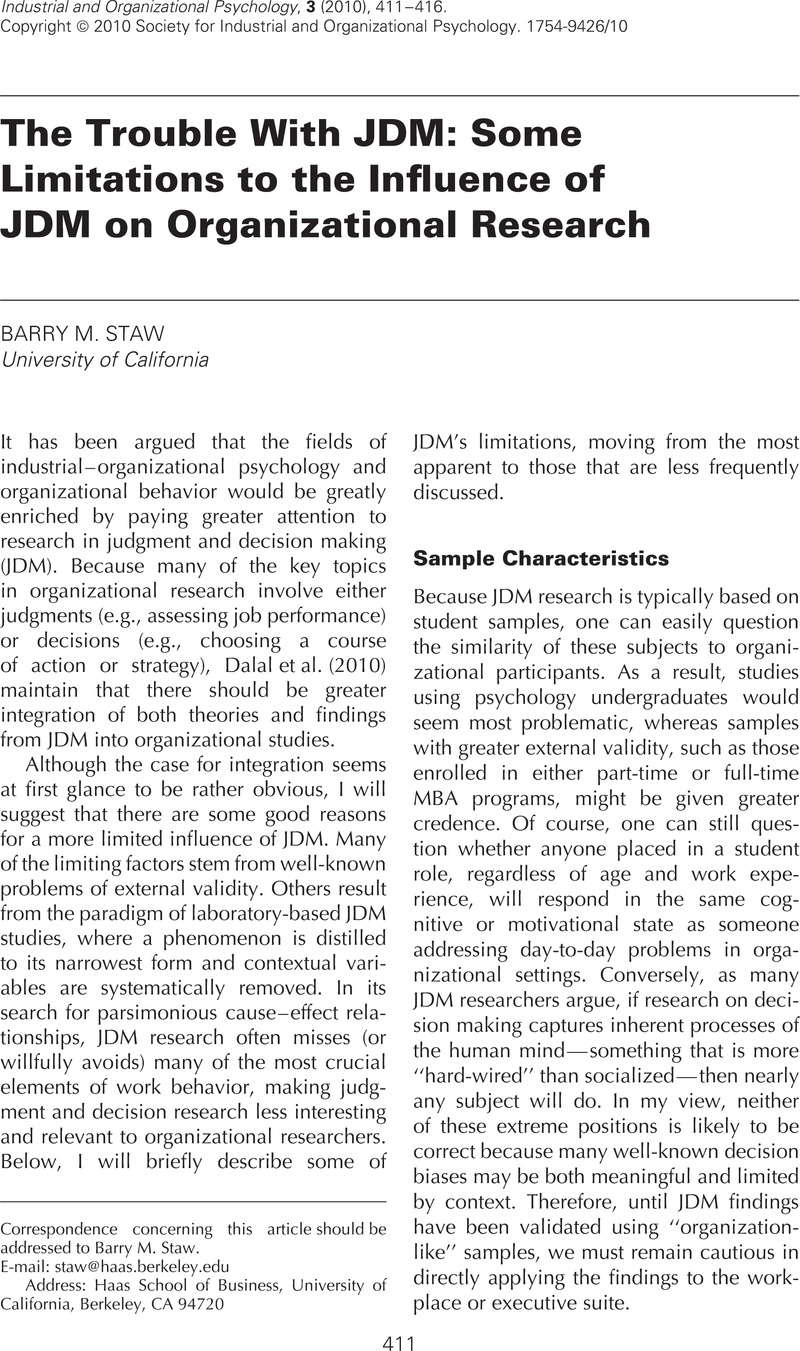Crossref Citations
This article has been cited by the following publications. This list is generated based on data provided by Crossref.
Bonaccio, Silvia
Dalal, Reeshad S.
Highhouse, Scott
Ilgen, Daniel R.
Mohammed, Susan
and
Slaughter, Jerel E.
2010.
Taking Workplace Decisions Seriously: This Conversation Has Been Fruitful!.
Industrial and Organizational Psychology,
Vol. 3,
Issue. 4,
p.
455.
Tsay, Chia-Jung
Shu, Lisa L.
and
Bazerman, Max H.
2011.
Naïveté and Cynicism in Negotiations and Other Competitive Contexts.
Academy of Management Annals,
Vol. 5,
Issue. 1,
p.
495.
Tsay, Chia-Jung
Shu, Lisa L.
and
Bazerman, Max H.
2011.
Naiveté and Cynicism in Negotiations and Other Competitive Contexts.
SSRN Electronic Journal,
Fiske, Susan T.
and
Borgida, Eugene
2011.
Best practices: How to evaluate psychological science for use by organizations.
Research in Organizational Behavior,
Vol. 31,
Issue. ,
p.
253.
Tsay, Chia-Jung
Shu, Lisa L.
and
Bazerman, Max H.
2011.
Naïveté and Cynicism in Negotiations and Other Competitive Contexts.
Academy of Management Annals,
Vol. 5,
Issue. 1,
p.
495.
Kwong, Jessica Y. Y.
and
Wong, Kin Fai Ellick
2014.
Fair or Not Fair? The Effects of Numerical Framing on the Perceived Justice of Outcomes.
Journal of Management,
Vol. 40,
Issue. 6,
p.
1558.
Kausel, Edgar E.
Culbertson, Satoris S.
Leiva, Pedro I.
Slaughter, Jerel E.
and
Jackson, Alexander T.
2015.
Too arrogant for their own good? Why and when narcissists dismiss advice.
Organizational Behavior and Human Decision Processes,
Vol. 131,
Issue. ,
p.
33.
Houdek, Petr
2016.
What Comes to a Manager’s Mind.
Journal of Management Inquiry,
Vol. 25,
Issue. 4,
p.
359.
Meikle, Nathan L.
Tenney, Elizabeth R.
and
Moore, Don A.
2016.
Overconfidence at work: Does overconfidence survive the checks and balances of organizational life?.
Research in Organizational Behavior,
Vol. 36,
Issue. ,
p.
121.
Hauser, Oliver P.
Linos, Elizabeth
and
Rogers, Todd
2017.
Innovation with field experiments: Studying organizational behaviors in actual organizations.
Research in Organizational Behavior,
Vol. 37,
Issue. ,
p.
185.
Röber, Björn
2018.
Escalation of Commitment in Internationalization Processes.
p.
113.
Meuris, Jirs
and
Leana, Carrie
2018.
The Price of Financial Precarity: Organizational Costs of Employees’ Financial Concerns.
Organization Science,
Vol. 29,
Issue. 3,
p.
398.
Röber, Björn
2020.
Escalating internationalization decisions: intendedly rational, but only limitedly so?.
Business Research,
Vol. 13,
Issue. 2,
p.
455.
Yip, Jeremy A.
and
Schweitzer, Maurice E.
2022.
Norms for Behavioral Change (NBC) model: How injunctive norms and enforcement shift descriptive norms in science.
Organizational Behavior and Human Decision Processes,
Vol. 168,
Issue. ,
p.
104109.
Junge, Sebastian
Luger, Johannes
and
Mammen, Jan
2023.
The Role of Organizational Structure in Senior Managers' Selective Information Processing.
Journal of Management Studies,
Vol. 60,
Issue. 5,
p.
1178.
Audia, Pino G.
and
Brion, Sebastien
2023.
A Carnegie plus Self-enhancement (CSE) model of organizational decision making under ambiguity.
Research in Organizational Behavior,
Vol. 43,
Issue. ,
p.
100194.



